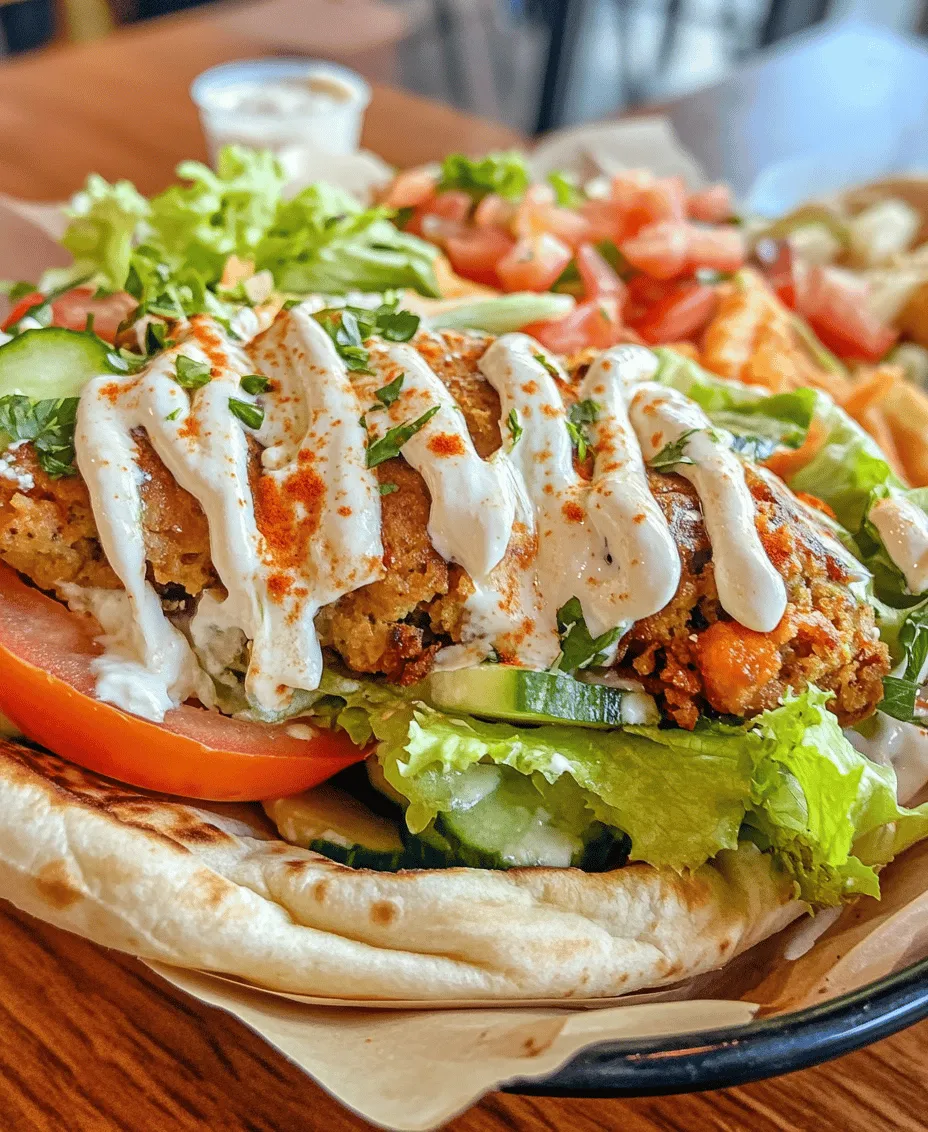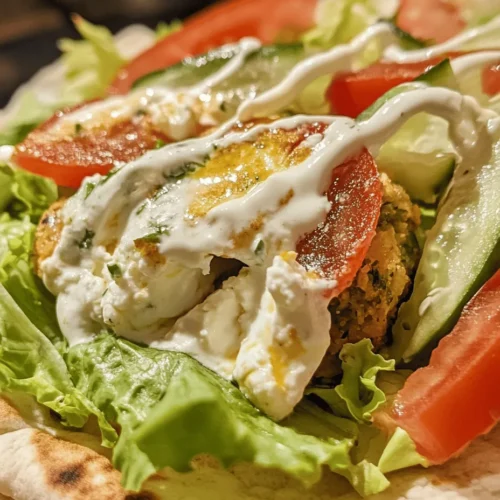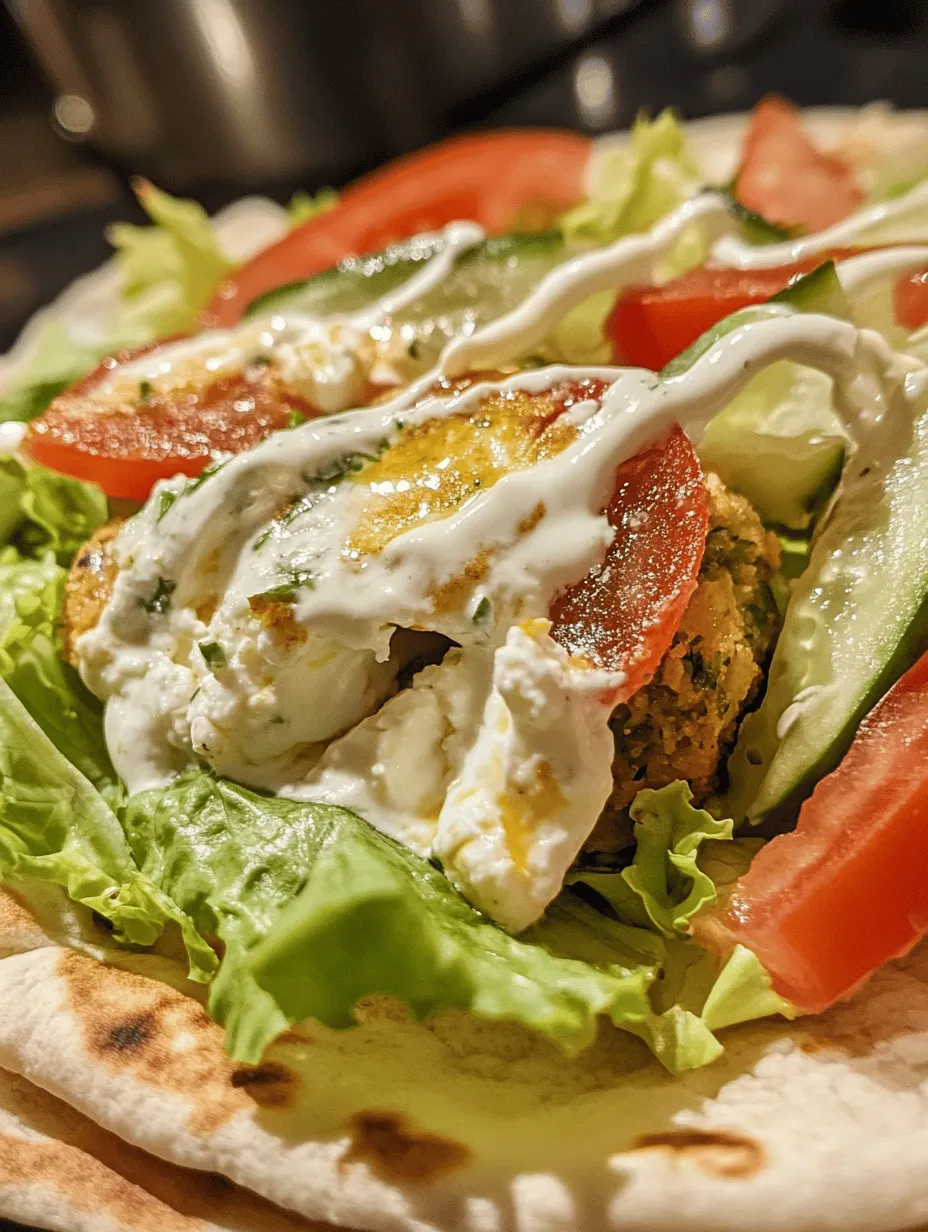Introduction to Mediterranean Feta-Stuffed Falafel
Mediterranean cuisine is a vibrant tapestry of flavors, colors, and textures, celebrated for its emphasis on fresh ingredients and healthy preparations. Among the array of mouthwatering dishes that hail from this region, falafel holds a special place in the hearts (and stomachs) of food lovers around the world. Traditionally made from ground chickpeas or fava beans, falafel is often enjoyed as a savory snack or a satisfying meal, typically served in pita bread or alongside salads.
In this article, we will explore a delightful twist on the classic falafel: the Mediterranean Feta-Stuffed Falafel. This version takes the traditional recipe and elevates it with the creamy richness of feta cheese, adding a burst of flavor that complements the herbaceous notes of the dish. Not only does this recipe promise a delicious experience, but it also offers nutritional benefits that make it a wholesome choice for any meal. Whether you are an experienced chef or a culinary beginner, this accessible and rewarding recipe invites you to bring the enchanting tastes of the Mediterranean right into your kitchen.
Exploring the Origins of Falafel
Understanding the roots of falafel can significantly enhance your appreciation for this beloved dish. Its history is rich and intertwined with various cultures across the Mediterranean and Middle Eastern regions.
Historical Background of Falafel
The origins of falafel are somewhat debated, with several theories regarding its inception. Some food historians suggest that falafel was first created in Egypt, where it was made from fava beans and served as a meat substitute during Lent by Coptic Christians. Others point to its roots in the Levant region, where chickpeas became the primary ingredient over time. Regardless of its beginnings, falafel has evolved into a staple food across the Middle East, gaining popularity in Mediterranean cuisine as it spread to countries like Israel, Lebanon, and Jordan.
Regional Variations Across the Mediterranean
As falafel made its way through various cultures, regional adaptations emerged, each adding unique flavors and ingredients. In Israel, for example, falafel is often made with a blend of chickpeas and spices, served in pita bread with tahini sauce and fresh vegetables. In contrast, Lebanese falafel may be enriched with spices like cumin and coriander, offering a more aromatic flavor profile. The addition of feta cheese in our Mediterranean Feta-Stuffed Falafel not only pays homage to these regional variations but also introduces a creamy texture that complements the crunchy exterior of the falafel.
The Rise of Falafel in Modern Cuisine
In recent years, falafel has seen a surge in popularity, transitioning from street food to gourmet offerings found in restaurants and cafes worldwide. As plant-based diets gain momentum and consumers seek healthier meal options, falafel has emerged as a go-to choice for both vegetarians and omnivores alike. Its versatility allows it to be incorporated into various dishes, from salads to wraps, making it a staple in modern culinary creations. The Mediterranean Feta-Stuffed Falafel is a perfect example of this evolution, merging traditional flavors with contemporary twists.
The Nutritional Benefits of Key Ingredients
Highlighting the health aspects of the Mediterranean Feta-Stuffed Falafel serves to inform readers about its nutritional value. Each ingredient not only contributes to the overall flavor but also provides significant health benefits.
Chickpeas: A Powerhouse of Protein and Fiber
At the heart of falafel are chickpeas, which are packed with protein and dietary fiber. A great source of plant-based protein, chickpeas help to support muscle growth and repair. Additionally, their high fiber content promotes digestive health, stabilizes blood sugar levels, and keeps you feeling full longer, making them an excellent choice for anyone looking to maintain a healthy diet.
Fresh Herbs: Parsley and Cilantro’s Health Benefits
The addition of fresh herbs like parsley and cilantro not only enhances the falafel’s flavor but also boosts its nutritional profile. Parsley is rich in vitamins A, C, and K, while cilantro is known for its antioxidant properties and ability to aid digestion. Incorporating these herbs into your falafel not only adds freshness but also contributes to overall well-being.
Feta Cheese: Nutritional Insights and Flavor Enhancements
Feta cheese, the star ingredient in our Mediterranean Feta-Stuffed Falafel, offers a delightful tanginess that elevates the dish. Made from sheep’s milk or a combination of sheep and goat’s milk, feta is lower in fat than many other cheeses, making it a healthier option. It is also a good source of calcium and protein, contributing to bone health and muscle function. The creamy texture of feta complements the crispy falafel, creating a delightful contrast that tantalizes the taste buds.
The Importance of Healthy Fats in Cooking Oils
When preparing falafel, choosing the right cooking oil is crucial for achieving the perfect texture and flavor. Opting for healthier oils, such as olive oil or avocado oil, can enhance the nutritional value of the dish. These oils contain monounsaturated fats, which are beneficial for heart health, and provide essential fatty acids that support overall well-being. By frying or baking your falafel in these oils, you can enjoy a delicious dish without compromising on health.
A Detailed Look at Ingredients
An in-depth exploration of each ingredient in the recipe provides readers with knowledge about their significance and alternatives, ensuring the recipe is adaptable to various preferences and dietary needs.
Dried Chickpeas vs. Canned Chickpeas
When preparing Mediterranean Feta-Stuffed Falafel, you have the option to use dried chickpeas or canned ones. Dried chickpeas offer a more robust flavor and require soaking and cooking, which can enhance the texture of the falafel. However, if you’re short on time, canned chickpeas can be a convenient alternative. Just be sure to rinse and drain them thoroughly to remove excess sodium. The choice between dried and canned will depend on your time constraints and flavor preferences.
The Role of Fresh Vegetables in Serving
Fresh vegetables play a crucial role in serving falafel, adding brightness and crunch to the dish. Common accompaniments include tomatoes, cucumbers, lettuce, and radishes, which not only enhance the presentation but also contribute valuable nutrients. You can also explore serving options, such as creating a falafel wrap with fresh veggies or a vibrant salad topped with tahini dressing. The possibilities are endless, allowing you to customize your meal to suit your taste.
Choosing the Right Type of Oil for Frying
When it comes to frying falafel, the type of oil you choose can greatly impact the outcome. While traditional recipes may call for deep-frying, pan-frying in a good-quality oil like olive oil or avocado oil can produce equally crispy results with less oil. If you’re looking for a healthier option, consider baking the falafel for a lighter version that still delivers great flavor. Each method has its benefits, so choose what works best for your cooking style.
Optional Ingredients: Breadcrumbs for Texture
For those looking to enhance the texture of their falafel, adding breadcrumbs to the mixture can be beneficial. This optional ingredient can help bind the falafel and create a slightly crunchy exterior. If you’re aiming for a gluten-free version, consider using gluten-free breadcrumbs or ground oats as a substitute. The addition of breadcrumbs is entirely up to personal preference, so feel free to experiment with this component to achieve your desired texture.
Step-by-Step Guide to Making Mediterranean Feta-Stuffed Falafel
Now that we’ve explored the origins, nutritional benefits, and ingredients, it’s time to dive into the step-by-step process of creating your own Mediterranean Feta-Stuffed Falafel. This detailed walkthrough will ensure that you achieve the perfect falafel, bursting with flavor and texture.
1. Soak the Chickpeas: If using dried chickpeas, soak them overnight in plenty of water. This will hydrate the beans and make them easier to blend. For canned chickpeas, make sure to rinse and drain them well.
2. Prepare the Mixture: In a food processor, combine the soaked chickpeas (or canned chickpeas), fresh herbs (parsley and cilantro), garlic cloves, ground cumin, coriander, baking powder, and salt. Pulse until the mixture is well combined but still slightly chunky. You want to retain some texture for the falafel.
3. Incorporate Feta Cheese: Gently fold in crumbled feta cheese into the chickpea mixture. This will infuse the falafel with a creamy, tangy flavor that elevates the dish.
4. Chill the Mixture: Transfer the mixture to a bowl, cover it with plastic wrap, and refrigerate for at least 30 minutes. Chilling helps the falafel hold its shape during frying or baking.
5. Shape the Falafel: Once chilled, take small portions of the mixture and shape them into balls or patties, about the size of a golf ball. Ensure they are compact to prevent them from falling apart during cooking.
6. Heat the Oil: If frying, heat a few inches of oil in a deep skillet over medium heat until it reaches 350°F (175°C). If baking, preheat your oven to 375°F (190°C) and line a baking sheet with parchment paper.
7. Cook the Falafel: Depending on your chosen method, either fry the falafel in batches until they are golden brown and crispy on all sides, or bake them in the preheated oven until golden and firm, turning halfway through.
8. Serve and Enjoy: Once cooked, remove the falafel from the oil (or oven) and drain on paper towels if fried. Serve warm with your favorite accompaniments, such as pita bread, fresh vegetables, and tahini sauce.
This comprehensive overview provides a solid foundation for your culinary adventure with Mediterranean Feta-Stuffed Falafel. The combination of rich flavors, nutritional benefits, and the joy of homemade cooking await you as you embark on this delicious journey into Mediterranean cuisine.

Preparing the Chickpeas: Soaking and Rinsing
The foundation of a great falafel lies in its chickpeas. For authentic Mediterranean Feta-Stuffed Falafel, it’s crucial to start with dried chickpeas rather than canned ones. Dried chickpeas provide better texture and flavor, making your falafel crispier on the outside while remaining fluffy inside.
Begin by rinsing 1 cup of dried chickpeas under cold water to remove any debris. Then, transfer them to a bowl and cover them with plenty of water. It’s important to soak the chickpeas overnight, allowing them to absorb water and expand, which typically takes around 8-12 hours. This not only softens the chickpeas, making them easier to blend, but also enhances their digestibility.
Once soaked, drain the chickpeas and rinse them thoroughly. This step is essential as it removes any remaining impurities and helps in achieving a smooth falafel mixture.
Crafting the Falafel Mixture: Balancing Texture and Flavor
With your chickpeas ready, it’s time to make the falafel mixture. In a food processor, combine the soaked and drained chickpeas, 1 small onion (roughly chopped), 2 cloves of garlic, 1 teaspoon of ground cumin, 1 teaspoon of ground coriander, and a handful of fresh parsley. Pulse the ingredients until finely chopped but not pureed; you want a texture that holds together when formed into balls.
Next, add salt and freshly ground black pepper to taste, and a tablespoon of baking powder. The baking powder is key for achieving a light and airy texture, allowing the falafel to puff up when fried. For an extra flavor boost, consider adding a pinch of cayenne pepper or a dash of paprika for a hint of heat.
Once combined, transfer the mixture to a bowl, and don’t forget the star ingredient: crumbled feta cheese. Gently fold in about 1/2 cup of feta, ensuring it’s evenly distributed without breaking it down too much. The feta not only adds a savory tang but also complements the earthy chickpeas beautifully.
The Importance of Chilling the Mixture
After crafting your falafel mixture, it’s critical to let it chill in the refrigerator for at least 30 minutes. This cooling period helps the ingredients to meld together, making it easier to form into balls or patties. Chilling also prevents the falafel from falling apart during frying, ensuring they maintain their shape and achieve that sought-after crispiness.
Stuffing Technique: Achieving Perfectly Stuffed Falafel
To achieve the signature feta-stuffed falafel, you’ll need to master the stuffing technique. With your chilled mixture ready, scoop a portion (about 2 tablespoons) into the palm of your hand. Flatten it slightly and create a small indentation in the center. Place a small amount of crumbled feta (about a teaspoon) in the center, then carefully fold the mixture around the cheese, forming a ball. Ensure there are no gaps; this will help keep the feta from leaking out during frying.
Repeat this process until all the mixture is shaped into stuffed falafel balls. You should yield approximately 12-15 falafel, depending on the size.
Frying Tips: Ensuring Even Cooking and Crispiness
Frying is where the magic happens, transforming your falafel mixture into golden, crispy delights. Heat a deep skillet or frying pan over medium-high heat and add enough oil (about 2 inches deep) for frying. Allow the oil to reach a temperature of 350°F (175°C). You can test if the oil is hot enough by dropping a small piece of the falafel mixture into the oil; if it sizzles and rises to the surface, you’re ready to fry.
Carefully lower the falafel balls into the hot oil, being cautious not to overcrowd the pan. Fry them in batches, allowing enough space for the oil to circulate. Fry for about 3-4 minutes on each side until they are beautifully golden brown. Use a slotted spoon to transfer the falafel to a plate lined with paper towels, absorbing any excess oil.
Serving Suggestions to Elevate Your Meal
Serving your Mediterranean Feta-Stuffed Falafel can elevate your dining experience. Here are some suggestions to make it a standout meal:
The Best Accompaniments: Pita Bread and Fresh Veggies
Start with warm, fluffy pita bread as the perfect vehicle for your falafel. Cut the pita in half and gently open the pockets. Fill each pocket with several falafel balls, adding a mix of fresh vegetables such as shredded lettuce, diced tomatoes, cucumbers, and red onions. The combination of crunchy veggies with the warm, savory falafel creates a delightful contrast.
Sauces that Complement Falafel: Tahini vs. Tzatziki
No falafel is complete without a delicious sauce. Consider serving your stuffed falafel with a drizzle of tahini sauce, which is made from sesame paste, lemon juice, garlic, and water. This creamy sauce adds a nutty flavor that pairs perfectly with the falafel’s spices. Alternatively, tzatziki—a yogurt-based sauce with cucumber and dill—provides a refreshing, tangy contrast that enhances the overall flavor.
Plating Ideas for Aesthetic Appeal
For an elegant presentation, arrange your falafel on a serving platter with an array of colorful accompaniments. Layer the pita, falafel, fresh vegetables, and sauces in a visually appealing manner. A sprinkle of chopped parsley or cilantro on top can add a burst of color, while lemon wedges on the side provide a zesty kick that invites diners to squeeze over their meal.
Variations and Customizations
Offering variations invites readers to experiment and adapt the recipe to their tastes. Here are some ideas to customize your Mediterranean Feta-Stuffed Falafel:
Vegan Alternatives: Omitting Feta and Using Nutritional Yeast
If you prefer a vegan option, you can easily omit the feta cheese and substitute it with nutritional yeast. This ingredient provides a cheesy flavor without the dairy, allowing you to maintain the savory essence of falafel. You can also add a splash of lemon juice to enhance the flavor profile further.
Gluten-Free Options: Alternatives to All-Purpose Flour
For those following a gluten-free diet, you can replace all-purpose flour with chickpea flour or almond flour. These alternatives not only cater to gluten sensitivities but also add extra flavor and nutrients to your falafel. Ensure that the baking powder used is also gluten-free.
Adding Spices for a Unique Flavor Profile
Feel free to experiment with the spice blend in your falafel mixture. Adding spices like turmeric, cumin, and coriander not only enhances the flavor but also adds a beautiful golden hue to your falafel. You could also try incorporating fresh herbs like mint or dill for a refreshing twist.
Environmental Impact and Sustainable Cooking
Addressing the environmental aspect of cooking encourages mindful eating. By choosing plant-based ingredients, you can significantly reduce your carbon footprint while enjoying nutritious meals.
The Benefits of Plant-Based Cooking
Plant-based cooking, like this Mediterranean Feta-Stuffed Falafel, is not only healthier but also more sustainable. By incorporating legumes, grains, and vegetables into your diet, you contribute to a more sustainable food system. Chickpeas, for instance, require less water and energy to produce compared to animal-based proteins, making them an eco-friendly choice.
Sourcing Ingredients Sustainably
Where you source your ingredients can also make a difference. Whenever possible, opt for organic produce and locally sourced ingredients. This not only supports local farmers but also reduces the environmental impact associated with transporting food over long distances.
Reducing Food Waste in the Kitchen
Being mindful of food waste is essential in sustainable cooking. Use leftover vegetables to create a refreshing salad or blend them into a sauce. Additionally, leftover falafel can be stored in the refrigerator for up to three days or frozen for later use, ensuring nothing goes to waste.
Conclusion
Mediterranean Feta-Stuffed Falafel is not just a meal; it’s a celebration of health and sustainability. By understanding the origins, nutritional benefits, and preparation techniques, you can appreciate this dish beyond its tantalizing taste. Whether enjoyed in a cozy home or a bustling gathering, this falafel recipe stands as an embodiment of Mediterranean culinary art, promising satisfaction for both the palate and the body. Embrace the flavors, explore variations, and make this recipe a staple in your culinary repertoire.


